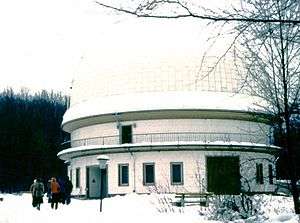Karl Schwarzschild Observatory

The Karl Schwarzschild Observatory (German: Karl-Schwarzschild-Observatorium) is an astronomical observatory originally founded in 1960 as an affiliated institute of the former Deutsche Akademie der Wissenschaften zu Berlin and named in honour of the astronomer and physicist Karl Schwarzschild. In 1992, the institute was refounded as Thüringer Landessternwarte (TLS, Thuringian State Observatory) ’Karl Schwarzschild’ Tautenburg. It is located in Tautenburg, Germany (10 kilometres north-east of Jena).[1]
The observatory has the largest telescope located in Germany, which is also the largest Schmidt camera in the world. Made by VEB Zeiss Jena (the branch of Zeiss located in Jena in what was then East Germany), this instrument is known as 2m "Alfred-Jensch-Teleskop": though its mirror is 2 metres in diameter, the telescope's aperture is 1.34m.[2]

On 5 April 2005 the observatory observed an exoplanet around the star HD 13189.[3]
The observatory also host an International station for the interferometric radio telescope LOFAR.[4]
See also
- Alfred Jensch
- Bernhard Schmidt
References
- ↑ "General". Retrieved 1 October 2014.
- ↑ "2m-Alfred-Jensch-Telescope". Retrieved 1 October 2014.
- ↑ "A giant planet around the massive giant star HD 13189". Retrieved 1 October 2014.
- ↑ "German LOFAR stations". ASTRON. Retrieved 2015-05-17.
External links
| Wikimedia Commons has media related to Thüringer Landessternwarte Tautenburg. |
Coordinates: 50°58′48.4″N 11°42′40.2″E / 50.980111°N 11.711167°E
|